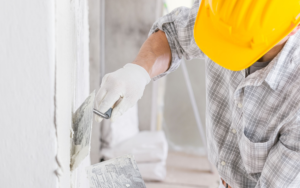Description 
Plasterers finish interior walls and ceilings with plaster materials, and apply durable cement plasters, polymer-based acrylic finishes, and stucco to exterior surfaces. When working with interior surfaces such as cinder block and concrete, they first apply a brown coat that provides a base, and then a second or finish (white) coat, which is a lime-based plaster. A primary base or scratch coat is necessary when plastering over a wire mesh (metal lath). For the finish coat, plasterers prepare a mixture of lime, portland cement, and water. This is quickly and carefully applied to the brown coat with a special tool known as hawk, a trowel, or a brush and water. It dries rapidly into a smooth durable finish. Modern drywall and wallboard surfaces may require only a single finish coat of plaster material. For exterior work, plasterers apply a mixture of portland cement and sand (stucco) over concrete, masonry, or lath. Small stones are sometimes added to the mixture to create a decorative finish.
Working Conditions
Because the plaster material can freeze, heat is usually necessary when applying plaster, and is needed to cure or dry it after it is applied. As a result, plasterers seldom work in cold conditions, and most plastering jobs are indoors. Some plasterers, however, do work outside when applying stucco to exterior surfaces. This type of work is more popular in the warmer parts of the country. Plastering is physically demanding, requiring considerable standing, bending, lifting, and reaching overhead. Good balance is required because plasterers frequently work from ladders and sometimes from scaffolds high above ground. The work can be dusty and dirty, and the plaster material soils shoes and clothing.
Aptitude and Interest
Plasterers must be very good with their hands and have very good eyesight, as the job requires the creation of both smooth and sometimes decorative surfaces. They should have no fear of heights, and the ability to read blueprints is often helpful.
Training
To become a skilled plasterer training is essential. This training can be acquired informally through learning-by-working with an experienced plasterer, through registered labor management apprenticeship programs, through company on-the-job training programs, and possibly by attending a trade or vocational-technical school. Although it is generally accepted that the more formalized training programs give more comprehensive skill training, most young men and women entering this occupation begin their career as helpers to experienced plasterers. Recommended high school courses include general mathematics, mechanical drawing, and shop.